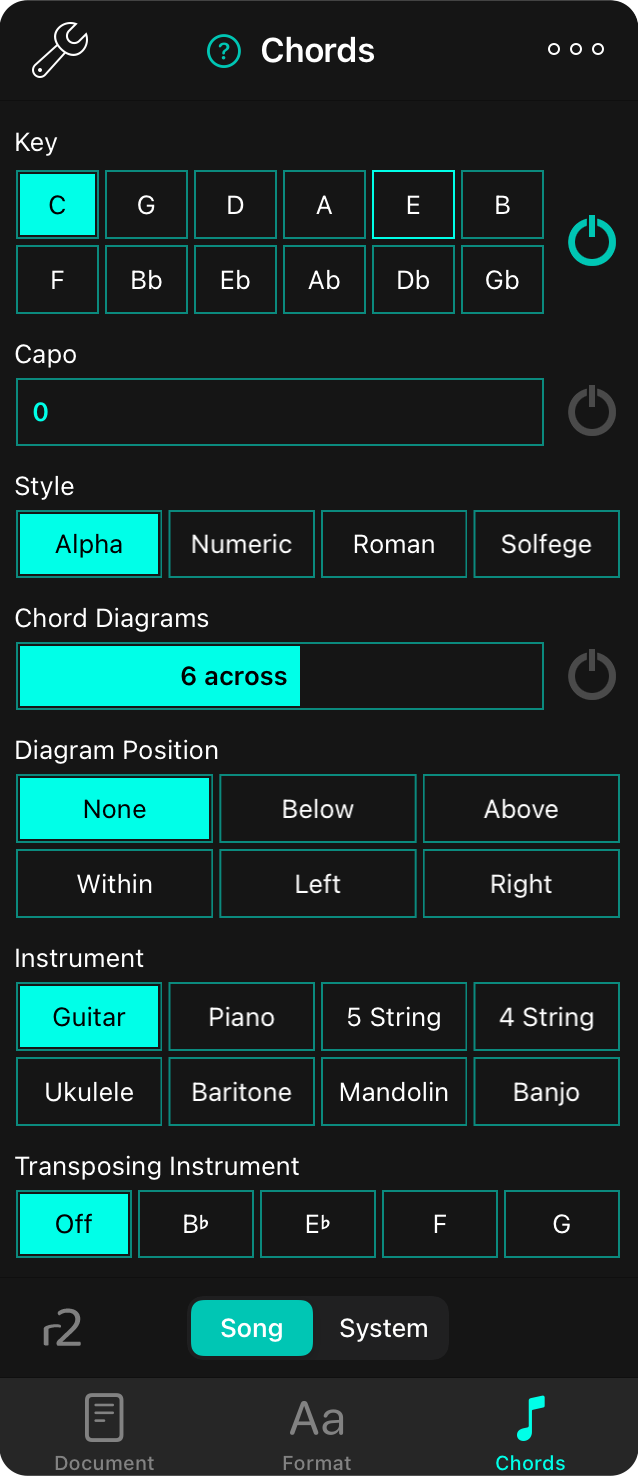User Manual
Chords

The chords tab lets you transpose and capo chords as well as determine how those chords appear. It also lets you select an instrument for chord diagrams.
The full style preferences menu is only available for text-based chord charts. However, if you have downloaded charts using a content provider like PraiseCharts or SongSelect, you will have access to transpose charts if you are signed in. OnSong will contact the content provider to download additional attachment as needed. If you already have attachments with keys matching the attachment type, you can also transpose between them without an Internet connection. Otherwise, if you are viewing an imported file you will have the option to Extract and Edit or Use Text Version.
Style
The style choosers lets you pick how the chords should appear on the screen. You can choose from the following options:
- Alpha displays chords as an alphabetic character (A-G) including enharmonic preference (sharp or flat). Default.
- Nashville displays chords as numbers (1-7) based on their position in the key.
- Roman displays chords as Roman numerals (I, ii, iii, IV, V, vi, vii) based on their position in the key.
- Solfege displays chords as numbers using Latin (do, re, mi, fa, so, la, ti) based on their position in the key. The "do" can be made fixed or movable by tapping on the wrench icon.
Key
The key chooser lets you set the key of the chord chart. This can be different from how the song was written in the song editor as transposition is performed from the original key to the one selected here.
The most common keys are presented in a "circle of fifths" order, placing keys with less sharps and flats toward the left. Keys switch between major and minor based on the how song is written. You can change this interface to be in alphabetic order, or to use the original slider interface instead using the Transpose Control option.
Users who prefer more options in keys or who want to access theoretical keys can turn on Theoretical Keys option.
Capo
The capo slider allows OnSong to adapt the chords based on capo position. This maintains the key of the song found in the transpose slider but alters the chords to work with the capo. You can capo from 0 to 11 and determine if the capo is applied by toggling the power button on the right.
By default, increasing the capo slider will modulate the chords of a song down. The reason for this is to allow the declared key of the song to be maintained. For instance, if the key of the song is C#, and a capo is applied on the first fret, then you should set the capo slider to 1. This will display the chords of the song down one half step in the key of C.
You can change how capo effects your chord chart in Settings » Display Settings » Song Formatting » Capo.
You can tap on the left and right sides of the slider to adjust the capo up and down one fret.
Diagrams
Diagrams can be drawn on the chord chart to help when you play, or for printing chord charts for educational purposes. You turn chords on and off with the power button to the right of the slider. Use the slide to adjust the how many diagrams can fit across one page from between 4 and 10 diagrams across.
You can tap on the left and right side of the slider to adjust the number of diagrams drawn across the page by one.
Diagram Position
The diagram position chooser lets you determine where diagrams and drawn on the page. You can choose from:
- None turns off chord diagrams. Default.
- Below draws diagrams under the song content.
- Above draws diagrams above the song content directly below the title and metadata.
- Within draws chord diagrams in place of chords within the lyrics.
Instrument
You can change the diagram instrument by choosing from the selection in the instrument chooser. You can also change the instrument by tapping on chords or diagrams in the song viewer to open the Chord Inspector. Here you can browse chord formations on different instruments. When the chord inspector is closed, the chord chart is redrawn with the last selected instrument's chord diagrams.
Transposing Instrument
If you are playing an instrument that does not play at concert pitch, you can adjust the chords that appear throughout the song to adjust for those instruments. Options include:
- Off used for concert pitch and most stringed or percussion instruments like piano.
- B-flat used for B-flat instruments such as trumpet, clarinet, bass clarinet, and soprano and tenor saxophones.
- E-flat used for E-flat tuned instruments such as soprano clarinet, or alto and baritone saxophones.
- F used for F tuned instruments such as French and English horns.
- G used for alto flute.
Methodology
Changes made in this menu do not modify the original content of the song as found in the song editor.
When you select a song in the All Songs list, the changes are applied to the master library. If you select a song in a book or set that has Separate Set/Song Styles enabled, the changes are only applied to the song within that set. This allows you to transpose a song in a different key for that book or set without changing the master version.
You can change the default behavior and interface options for this screen by tapping the wrench icon in the upper left corner to change Style Preference Chords options.


